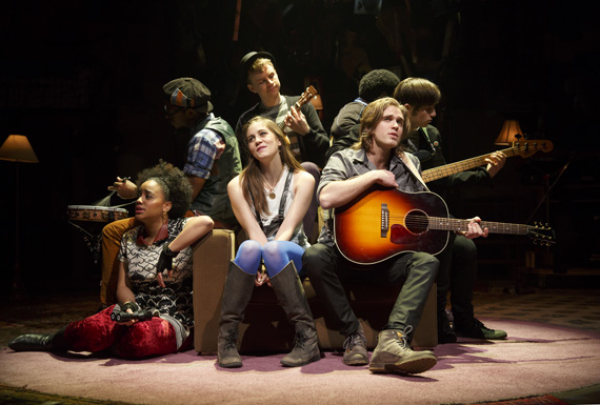What’s It All About? Bacharach Reimagined

(© Eric Ray Davidson)
New York Theatre Workshop has been transformed into your living room. That is, if your living room sported a two-ring rotating stage and giant installation art piece of stringed instruments. Still, despite such grandiosity, the hominess and comfort is palpable in What's It All About? Bacharach Reimagined. Conceived by singer-songwriter Kyle Riabko (who has appeared on Broadway in Spring Awakening and Hair), this awesome set of rearranged Burt Bacharach songs has all the feeling of a really great living-room concert. Feel free to sit back, relax, and enjoy some excellent music performed by fresh-faced and extraordinarily talented musicians.
The tone is set from the moment you enter the space: The normal house lights have been replaced by mismatched table lamps on ledges. Audience members sit on big comfy couches at either end of the stage. The performers hang out on sofas psychedelically suspended seven feet off the ground against the upstage wall. Every inch of wall is covered by rugs of varying size, shape, and ethnic origin. This smart choice by set designers Christine Jones and Brett J. Banakis not only makes you feel like you’re in a giant unrenovated 1970s rec room, but it doubtlessly aids Clive Goodwin in his sound design (flawless) by cutting down on reverb. (Don’t you love it when design is simultaneously practical and beautiful?)
The affable Riabko emerges and introduces himself and his band, explaining the origins of this show: In 2010 Riabko met Bacharach at a recording session. That year he started rearranging Bacharach’s music and recording demos, eventually receiving the Grammy Award-winning composer’s blessing (as well as that of lyricist Hal David) to turn them into a stage show. That’s the end of the chitchat. What follows is 90 minutes of nonstop aural stimulation.
Riabko and company present variations on Bacharach classics like “I Say a Little Prayer,” “(They Long to Be) Close to You," and “A House Is Not a Home.” A supercharged medley of “Message to Michael,” “On My Own,” and “Do You Know the Way to San Jose” is a highlight. “What the World Needs Now Is Love” is an anthemic finale, overflowing with hope. The title, “What’s It All About?,” comes from the song “Alfie,” which Bacharach has cited as a personal favorite. This lyric serves as connective tissue for the entire evening, regularly weaving in and out of other songs and transitions. It gets its own moment in the spotlight in a heartfelt solo by Riabko, who perches high atop one of the sofas with an acoustic guitar.
Everyone in this show plays about five different instruments, switching constantly between songs. The sheer virtuosity displayed on stage is astounding. Daniel Bailen plays Bass (guitar and double) and performs with the voracity of a starving man eating his first meal in days (seriously, it looks like he’s chewing on something up there). Laura Dreyfuss and Nathaly Lopez bring the house down with their powerful vocals, invoking such greats as Dionne Warwick and Aretha Franklin. James Nathan Hopkins plays keyboards, but also mandolin and ukulele. Daniel Woods rocks out on the guitar and piano. James Williams keeps the beat for these powerfully percussive arrangements. Everybody sings.
Director Steven Hoggett has created small moments and specific images that illuminate the lyrics without drawing focus from them: hugging an empty shirt, quietly ripping up a letter, slowly releasing flower petals onto the floor. His choreography is fun and works naturally with the music, sending tingles up the spine when the whole cast moves together. Secretly, all directors really just want to make music videos. What’s It All About? has all the elements of a really memorable one.
Most of all, there’s the music. Riabko prefaces that this is “my generation’s take” on Bacharach. Yet he draws influence from over a century of American musical styles: blues, jazz, country, bluegrass, and R&B, to name a few. Just when you think you’ve got his sound pinned down, he gives you something new. The result is an evening with the history of American popular music, without any pretentious or saccharine monologues about the history of American popular music. It’s an auditory smorgasbord that exposes the endless possibilities in a simple melody. Bacharach couldn’t ask for a finer tribute.










